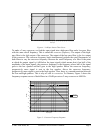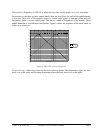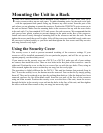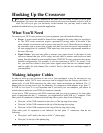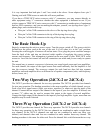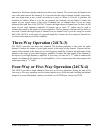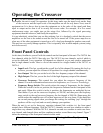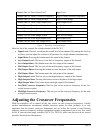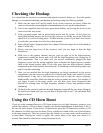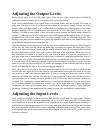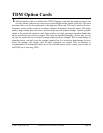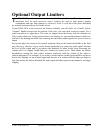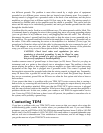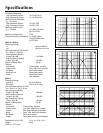
© 2003 TDM Audio, Inc. Electronic Crossover Owner’s Manual Page 17
Adjusting the Output Levels
Start with the input levels at 0 dB (unity gain). After the rest of the system has been dialed in
(amplifier gains and output levels), the input levels can be fine tuned.
Feed a lower-than-normal level signal from your signal source into the system. You want to
make sure that you set it up so you have room to spare. If you can get enough volume out of the
system when your input signal is at -10 dBm then you probably have enough gain, so use some
program material such as recorded music and adjust the level of the signal source so you are
feeding a -10 dBm average signal. If you are using a mixing console, the output meters should be
reading -10 dBm on most of the signal peaks, and a little higher on the highest peaks. If you have
equalization on the system, make sure it is set to completely flat, or bypassed altogether. This
applies to the main system equalizer as well as any equalizer that affects your signal source such
as the channel equalizer on a mixing console.
Turn the output levels on the crossover all the way down and then turn the power amplifier gains
all the way up. Start with the frequency band that you expect to require the most gain. If you
don’t know which one that is, begin with the middle band in a three-way system or the band with
the most mid frequencies in a two-way system (often this is the high band). Raise the level of
this band until its volume is as loud as you ever expect to need it. If you are inexperienced, it
may take some time to understand how much gain you need for a particular application, but it is
often best to have a little more than you need because you can always turn it down at the source
if it is too loud. If you cannot get enough volume with the output level all the way up, raise the
input level until you have enough. If you cannot get enough volume with the input level and the
output level both all the way up then you need bigger amplifiers.
Next, raise the levels of each of the other bands to match the level of the one you have already
set until you have them all set so the sound is even and natural. Once you have them all set, you
may need to go back and fine tune them a bit. If you are setting up a three-way system, set the
mids first, the highs next, and the lows last. As you are setting the output levels of the crossover,
remember that you are mainly trying to get the overall levels of the various speaker components
to match. The system may require equalization to even out the frequencies after the crossover is
set. A common mistake in a three-way system is to set the highs and low outputs too high to
compensate for some mid frequency that is too hot in the midrange speakers. Then when that
frequency is reduced with equalization, the sound is crispy, dry, and generally unintelligible.
Adjusting the Input Levels
After setting up the entire system, you may find that the overall gain isn’t quite right. In some
cases the level of the first speaker component was set a little to high, and after all of the others
were brought up to match, the overall level is too high. In live sound reinforcement situations, it
is often the case that an approximate level is set up, and then when the event begins and the room
fills up with people, or the PA has to start competing with the sound coming off the stage, there
is not enough gain in the system and it must be increased. Use the input levels on the crossover
for these situations.



